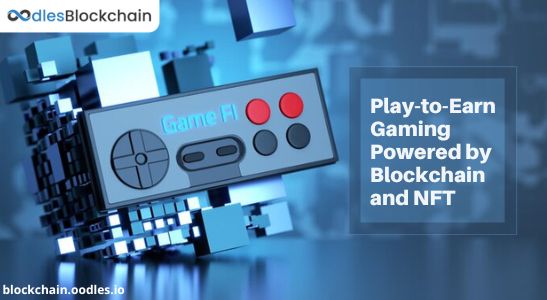-
This blog is for you if you're a start-up enthusiast aiming to build and launch a play-to-earn (P2E) gaming business with blockchain and NFT technologies. At Oodles, we deliver full-stack game development through our Play-to-Earn Game Development Services and NFT Game Development offerings — covering smart contracts, tokenomics, and immersive game economies. Here, we share key insights that decision-makers should keep in mind before and during the development of NFT-based P2E games.
Play-to-Earn and Traditional Gaming
Traditional gaming generally operates on the "closed-end model". To advance or unlock prizes, players spend a lot of time grinding and performing tedious activities in a game. Yet, eventually, they do not get the authority to transfer or sell those earned assets. They are forced to follow rules set by the centralized gaming industry. It can add rules or otherwise alter them whenever they like.
Contrarily, play-to-earn games enable gamers to play games and earn in return for their hard work. Especially, with blockchain and NFT-based play-to-earn games, by performing tasks, engaging in player battles, or advancing through different game levels, gamers receive prizes in the form of in-game assets such as crypto tokens, virtual land, avatars, weapons, and other non-fungible tokens, or NFT. Additionally, unlike conventional games, play-to-earn games allow players to purchase and transfer in-game assets like NFT outside of a game's virtual environment due to their blockchain-based structure.
You may also like to explore | Play-to-Earn NFT Games | Fundamentals and Development Essentials
The Convergence of NFT, Blockchain, and Play-to-Earn Games
Play-to-earn games have their virtual economies. They each have unique crypto tokens that are constructed on the blockchain of a particular cryptocurrency (often Solana, Ethereum, or its layer 2 chain, Polygon), and the supply and demand of their tokenomics change.
Each game's model and economy are different. Still, all of these in-game items have the potential to give players some financial advantage, whether it be because they won a battle and received cryptocurrency, sold an in-game NFT on the market, or charged another player rent to stay on their virtual property.
It's interesting to note that wherever blockchain enters a sector, it introduces decentralization and autonomous governance. Industries like music and art have already been transformed by it. Game time has arrived.
Also, Check | How to Develop Play-to-Earn Game in Sandbox
Understanding Play-to-Earn Games' Economies that Involve NFT
Creating a play-to-earn economy requires developers to consider more than simply their bottom line.
In this scenario, players and developers resemble business partners. It operates in the following way for NFT-based play-to-earn games.
Holding valuable assets and distributing them via trading are the players' responsibilities in the partnership. This ought to increase the number of players in the game. The developers' revenue also rises as demand for the game's NFT collection does. There is one crucial aspect that developers must consider.
It costs money to produce NFTs, and that money needs to be returned. The developer profits from a reduction in transaction fees. This results in revenue for the developer each time an NFT is transferred.
Latest | GameFi | The Next Big Thing in the Crypto Space
Let's assume that the royalty rate for a skin NFT is set at 2%. Every time this NFT is sold to a different player, the NFT's original inventor (the developer) will profit. Not just the first few instances, but always. Therefore, the developers need to be careful to determine a fair price. In addition, they ought to keep urging gamers to transfer these assets.
What about the games that distribute current cryptocurrencies? How do they generate income?
Most frequently by showing gamers advertising. Here, time is a crucial element. The creators should be getting enough ad money as long as players spend a lot of time playing the games to acquire some cryptocurrency.
Gaming Guilds to the Rescue
Gaming Guilds made up of investors, players, and managers can address many of the issues with sustainable inflow and upfront capital investment. They buy in-game items like land and in-game assets in the form of NFT and then lend them to new players who might want to try out the new format, earning yields by using those gaming assets in the respective virtual worlds. The guilds then make money off of the gamer by splitting their profits and the rent they receive. The goal is to make it easier for people to participate in P2E games without having to invest money upfront.
Popular NFT Play-to-Earn Games
CryptoKitties
The Ethereum-based blockchain game CryptoKitties, created by Canadian studio Dapper Labs, enables players to buy, collect, breed, and sell virtual cats. One of the first initiatives to gamify decentralized finance was this one.
Decentraland
Players can acquire virtual land in this 3D environment, construct it, and then rent or sell it to other players in exchange for MANA, a cryptocurrency that functions on the Ethereum blockchain. When best Best Blockchain Platforms for Games Development
Most Resourceful Blockchain Platforms for Building NFT P2E Games
Ethereum
It is a public blockchain network whose nodes are spread worldwide. With Ethereum development services, you can create software and write code to manage money. The goal of Ethereum's blockchain is to execute a decentralized application's source code.
Tron
Decentralized application development and deployment are accelerated and made simpler by Tron. TRX is the cryptocurrency that Tron retains. Tron creates an ecosystem where users can access digital assets by sharing content.
Begin with Conceptualization and Ideation
Start with a proposal that, in your opinion, meets the needs of the user and the market, taking into account things like NFT integration, in-game economies, and game mechanics. At Oodles, speaking with our blockchain experts can assist in defining precisely what needs to be planned, carried out, and accomplished. Next, we choose the best technology and tools to put your idea into practice.

Our Offices
INDIA
Emaar Digital Greens, Sector 61,
Gurugram, Haryana
122011.
Welldone Tech Park,
Sector 48, Sohna road,
Gurugram, Haryana
122018.














